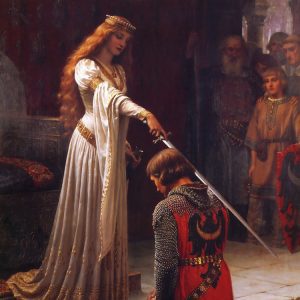Frame the Scene: Even when the GM suggests the scene, one player should be the focus of the scene. This player will frame the scene by describing where and when it takes place. Flashbacks are common, but scenes taking place in the future should be avoided except by more experienced and flexible groups.
The player should also describe what the intended goal is in the scene. Other players may choose to participate in the scene if it makes sense that they would be present. They also choose at this time whether to accept the current risk and reward proposal. They cannot create their own risks and rewards, but they can be in the scene without agreeing to the risk and reward.
Example 1 for Framing the Scene: Rob describes his character as being as a young apprentice struggling in one of the Bemmea’s academies. His character gets sent to Archmage Hugo’s advanced class with a message from another instructor just as the archmage begins expounding the virtues of a particular ancient rune. None of the other PCs have history in Bemmea so their PCs won’t be in this scene.
Example 2 for Framing the Scene: Mary describes how her character advances on the gate to the lord’s keep in a cocky manner. Her fighter can hear a horse whinny from the stables on the other side. The guards stop their chatter and look up at Mary’s character. A smile crosses one’s face as he recognizes her. Her armor may be fancier, but she doesn’t look so different from the upstart he tossed in the mud two years ago. Mary’s fighter cracks her knuckles and advances. The other players decide that they also want to be a part of the scene. Not only do they need mounts, but they also don’t want to miss this opportunity. Henry’s character doesn’t have many healing surges, however, and so he doesn’t accept the risk vs. reward. Mary offers to risk two surges so her fighter can steal an extra horse, and the GM agrees.
Play the Scene: There is no grid and no minis in a transition scene. The GM and each player describes character actions (both PC and NPC) as needed to advance the story of the scene, keeping in mind that the framing player is the focus. If some PCs are not present in the scene, the GM should feel free to invite them to play NPCs. After the scene has reached a climax or nears resolution, the GM should pause the scene. Generally scenes play out in just a few minutes.
Example 1 for Playing the Scene: Rob continues the story of how his character is intimidated by the legendary Archmage Hugo as he lectures. His character shrinks against the wall, unwilling to interrupt, and seems to go unnoticed. Something about that moment clicked for the young apprentice. He could almost remember the chalk images of the Rune of Undoing. Elliott remembers that Rob’s rival also went to the academy and suggests adding him as a student in the classroom so that he can join in on the roleplaying fun. Elliott roleplays how the rival notices Rob and calls him out as an outsider. Hugo is interrupted and turns on Rob’s PC in anger.
Example 2 for Playing the Scene: Mary’s fighter weaves in and out of the lord’s thugs, knocking them this way and that. Her fighter’s allies follow her lead, remembering the time they kept their footing on the deck of the longship Calibar amid a fight. Her fighter takes great joy as she knocks one guard into a mud hole and pushes his face down with the heel of her boot.
Resolve the Scene: Each player who did not accept the risk and reward votes on whether the scene ended favorably or unfavorably for the focus PC. The GM breaks any ties and casts the only votes if all the PCs accepted the risk and reward.
You then return to the scene and play out the ending, wrapping things up so the regular game can continue. If the scene ended favourably, the PC(s) get to keep the risked resource and gain the agreed reward. If the scene ended unfavourably, the PC(s) lose the risked resource but still gain a reward. The GM may decide that gaining the intended reward does not make sense and grant an alternative reward in its place.
In either case, we moved the story forward and were able to learn something about one of the PCs, which is the whole goal for transition scenes.
Example 1 for Resolving the Scene: Rob’s scene ends unsuccessfully because his character gained the ire of a wizard he respected and looked up to. So, the apprentice delivers the message and flees the room quickly. Rob hints that this may be one of the events that led to his general dislike of other arcanists of Bemmea, and it certainly explains his previously mentioned rivalry. The GM briefly considers granting a different reward, but decides that the emotional impact of the event is all the more reason why Rob’s character would remember what he saw. Rob makes a note that he gets a +2 Arcana bonus to a future roll to disarm a trap.
Example 2 for Resolving the Scene: Mary’s scene ends successfully. The party thrashes the lord’s guards and rides into the night with its ill-gotten mounts. Mary has also shown that her character has a vengeful streak and she possibly made her fighter into a target for the lord and his allies—excellent fodder for the GM to use in later sessions.

